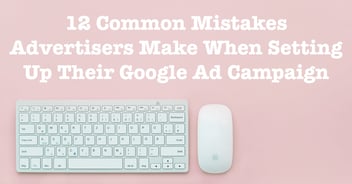
I can’t tell you the number of times I have clicked on an intriguing ad but immediately left the landing page because it was either irrelevant and disconnected from the ad’s message, lacked a clear call-to-action (CTA), or completely missed the mark on positive user experience.
When building a landing page, it’s crucial to have a process in place to help focus your attention on the end goal: conversions. Follow these 10 steps to optimize your landing page for conversions!
1. A Strong, Compelling Headline
As you begin to design your landing page, it’s essential to keep your customers’ needs in mind. What is going to capture their attention? How are you going to encourage them to move through your page?
Start with a strong and compelling headline. Your headline should clearly state what product or service you’re trying to promote. If your site visitors are directed to the landing page from an ad, then your headline and content needs to align with the ad copy to avoid any confusion–and even worse, users bouncing from your page without converting. (Learn about writing ad copy in step six!)
2. Purposeful, Clear, and Concise Content
The purpose of your landing page content is to help users navigate through the page. Every word on the page should help users understand your offer and drive them to complete the form. If you notice content on your landing page that doesn’t serve this purpose, delete it. Users should be able to fully understand and complete your form quickly. If they can’t, you’re almost certainly losing potential leads.
3. Simple, User-Friendly Form
According to WordStream, conversion rates take a large dip if a landing page form contains more than seven fields. Try to strike the perfect balance between requesting enough information to qualify users as leads and overloading them with too many questions. You can also simplify your forms for users with option buttons or drop downs and directional visual cues to speed up the completion process. If you want to learn more about optimizing your forms for conversions, check out this Blue Frog blog article!
4. Clear CTAs
A simple, user-friendly form is a great start, and tying it together with a clear CTA can make all the difference in driving conversions. When a user lands on your page, the goal is to convert them into a lead. To do so, you must command their attention and draw their eyes to one place. Unbounce explains that the ideal “attention ratio”–the ratio of the number of things a user can do on the page to the number of things you really want them to do–is 1:1.
A great way to improve your CTA clickthrough and conversion rates is through A/B testing. In this way, you can test different variations of CTA colors or content and use the data you collect to optimize your landing page. For example, you could A/B test the CTA, “Learn More,” against, “Schedule a Demo” to see which performs better.
5. Customer Testimonials
Another way to optimize your landing page for conversions is to build credibility. A simple way you can do this is by including customer testimonials on your landing pages. Previous customers’ positive feedback showcases your quality of work and experience and helps to establish trust with your potential leads.
6. Corresponding Ad Text
One reason aligning your ad copy to your landing page headline is important is to maximize Google Ad Rank. Google assesses your landing page experience based on how well your site gives users what they’re looking for when they click on your Google ad. This landing page experience analysis affects your Google Ad Rank, and, as a result, your cost per click (CPC) and position in the Google auction.
An easy way to improve your landing page experience is to make sure your page headlines and content match what you promote in your ad. You should also focus on making your content clear and relevant, establishing trust, and using a mobile-friendly design.
7. Clean, Visually Appealing Design
A clean, visually appealing design will draw users in and smoothly navigate them through your page. WordStream offers several key takeaways and great examples of well-designed landing pages here.
8. Relevant, High Quality Images
Use professional quality images that are relevant to the product or service you’re trying to promote. They say a picture is worth a thousand words, and in this case, it’s worth conversions, too! If your images create any sense of disconnect between the content on the page and your offer, it could be enough to prevent some users from completing your form.
9. Mobile-Friendly Design
With millions of users searching on mobile devices, why wouldn’t you make your landing pages mobile-friendly? When designing a landing page to be mobile friendly, it’s important to keep it simple yet effective. Neil Patel discusses six conversion elements for mobile-friendly landing pages that you won’t want to miss when designing your next page!
10. Thank-You Page and Conversion Tracking
The last–and probably most important–step in creating landing pages that convert is to set up conversion tracking to understand the path users took to convert on your page.
At Blue Frog, we set up our conversion tracking by building thank-you pages. Once a user fills out a form, they are immediately redirected to a thank-you page, where a conversion tracking tag is fired to allow us to count the lead as a conversion. We’re then able to see exactly which keyword, ad, ad group, and landing page converted the user!
Before you design your next landing page, remember to apply these 10 steps to optimize for conversions! If you’re looking for help with your landing pages, contact our digital advertising team at Blue Frog for a free consultation and strategy recommendation!



